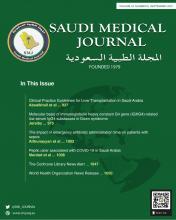Clinical Practice Guidelines
Clinical Practice Guidelines for Liver Transplantation in Saudi Arabia
Abaalkhail et al presents this Clinical Practice Guidelines (CPG) to help physicians and other healthcare providers evaluate candidates for LT and correctly manage LT patients in KSA. It generates evidence and recommendations according to the Grading of Recommendations Assessment Development and Evaluation (GRADE) system. The principles of the GRADE system reflect the quality of underlying data. They discuss that there are 2 grades of recommendations: strong and weak. If the evidence quality is higher, a strong recommendation is necessary; if the inconsistency in values or ambiguity is more, then a weaker recommendation is granted.
see page 927
Original Articles
Molecular basis of immunoglobulin heavy constant G4 gene (IGHG4)-related low serum IgG4 subclasses in Down syndrome
Comparison of immunoglobulin heavy constant G4 gene (IGHG4)/36B4 ratios: Down syndrome (DS) with low IgG4 level, DS with normal IgG4 level (N IgG4), healthy control and IGHG2/36B4 ratios, IGHE/36B4 ratios
Jeraiby investigates the molecular mechanism of low serum IgG4 at the level of the immunoglobulin heavy constant G4 gene (IGHG4). Patients with Down syndrome (DS) are more likely to exhibit immunological abnormalities that predispose them to infection. Among other anomalies, individuals with DS have altered serum concentrations of some subclasses of immunoglobulin G (IgG), particularly the IgG4 subclasses. He concludes that the heavy chain gene IGHG4 haploinsufficiency is highly correlated with low serum IgG4 in our population with DS, but other relevant factors must be assessed in future work.
see page 975
The impact of emergency antibiotic administration time on patients with sepsis
Illustrate the mortality rate among both groups for sepsis and severe sepsis patients
Althunayyan et al conclude that their findings did not support immediate antibiotic administration over early administration in patients with sepsis. Out of 495 septic patients, only 292 patients (mean age of 56.3 ± 23.6 years) met the inclusion criteria. Two hundred fifty (85.6%) patients received antibiotics within one hour of triage (immediate), while 42 (14.4%) patients received antibiotics between one and 3 hours (early). Overall, in-hospital mortality was 31.8%. The mortality rates among patients who received early antibiotic was 31.6% and who received immediate antibiotic was 33.3%, with a p-value of 0.823.
see page 1002
Case Report
Peptic ulcer associated with COVID-19 in Saudi Arabia
Demonstrates both intraperitoneal and retroperitoneal foci of air suggesting ruptured viscous (black arrow)
Merdad et al present a 23-year old male patient came to the emergency room suffering from acute abdominal pain and vomiting. The patient appeared to have a complicated course of infection with gastrointestinal manifestations and a perforated duodenal ulcer without any respiratory symptoms. Laboratory and radiographic investigations revealed positive results for COVID-19. The chest CT showed a ground-glass appearance. Accordingly, the patient was referred for an emergency laparotomy and was treated mainly for a perforated duodenal ulcer. Unfortunately, the patient died due to several complications. Patients presenting with gastrointestinal symptoms during this pandemic should be assessed for COVID-19 infection, even if respiratory symptoms are absent.
see page 1036
- Copyright: © Saudi Medical Journal
This is an Open Access journal and articles published are distributed under the terms of the Creative Commons Attribution-NonCommercial License (CC BY-NC). Readers may copy, distribute, and display the work for non-commercial purposes with the proper citation of the original work.









